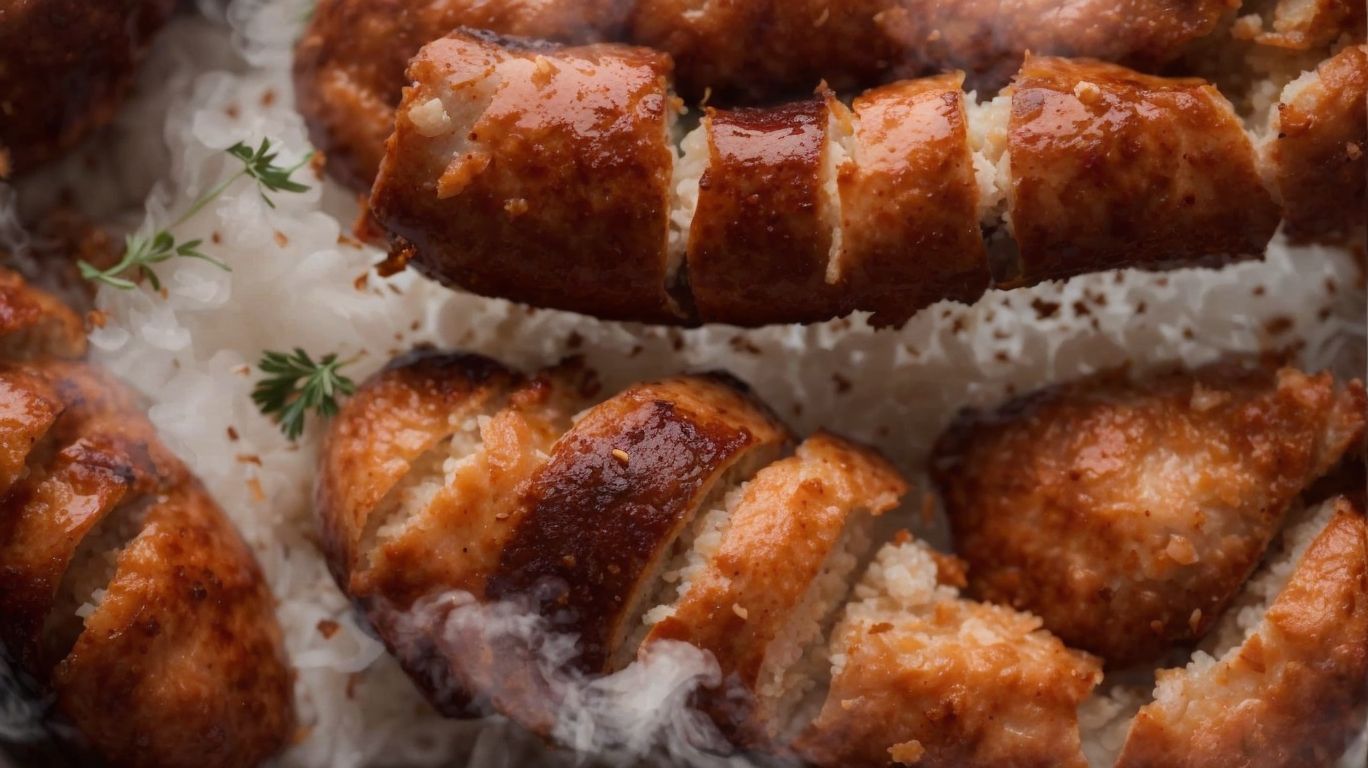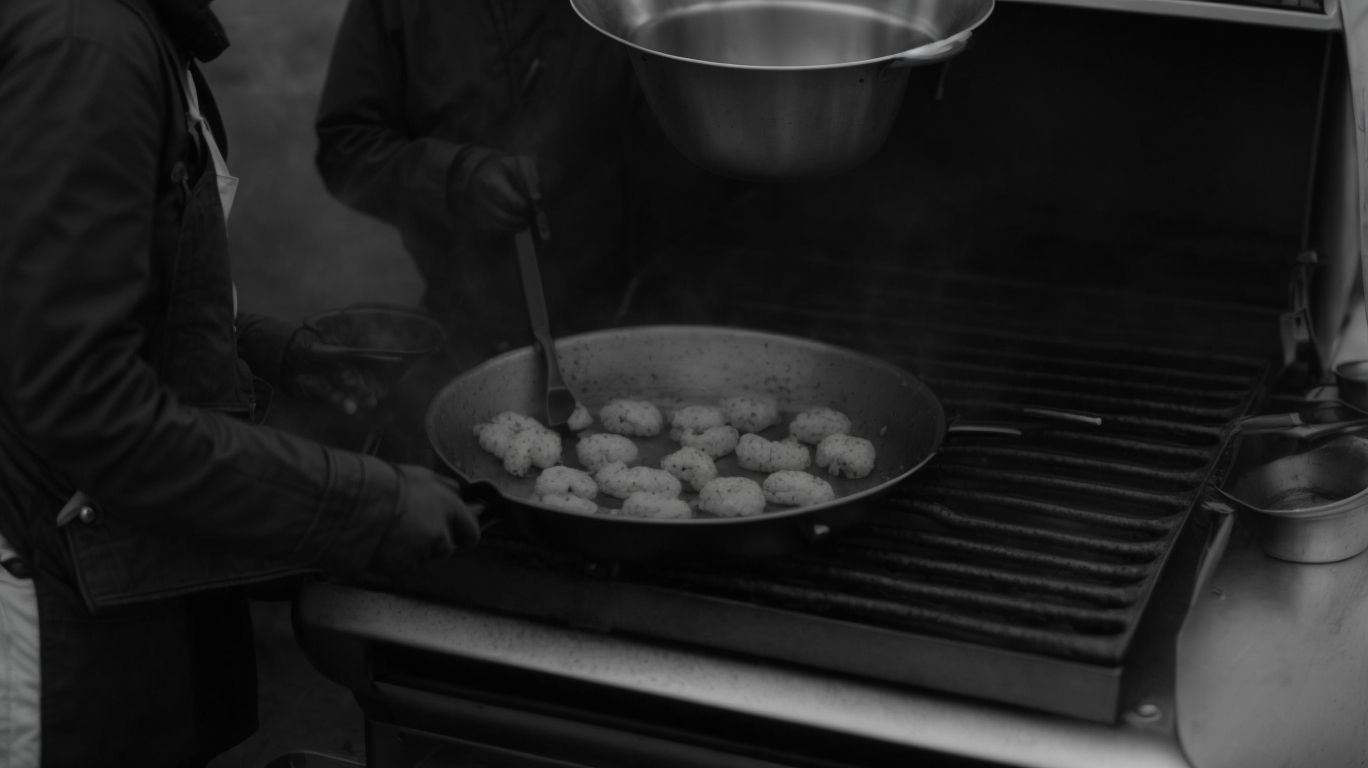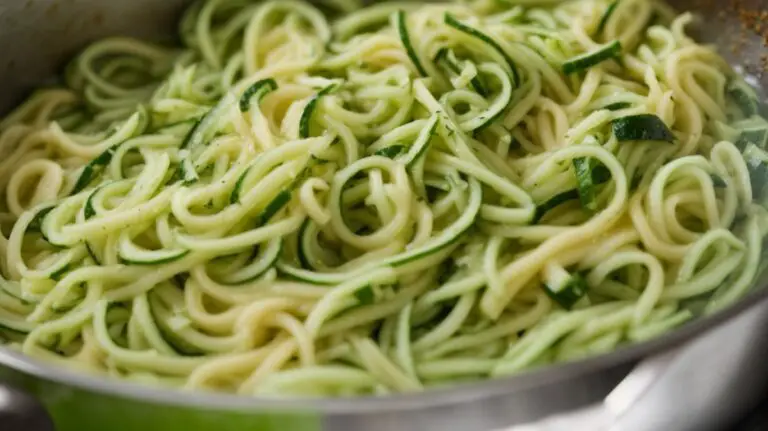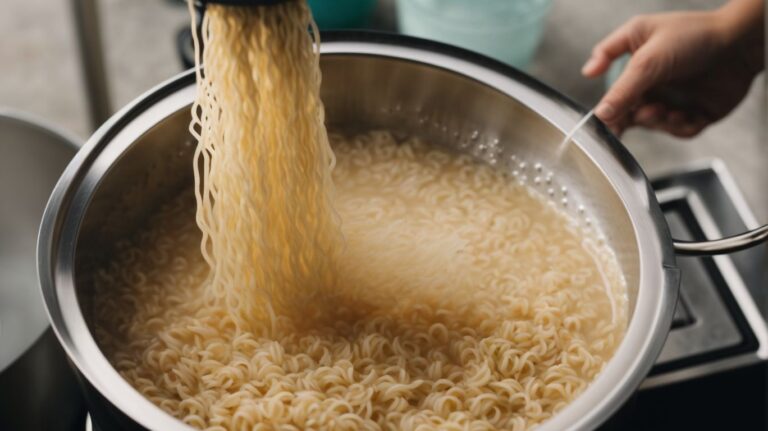How to Cook Boudin Without It Exploding?
Have you ever wondered what exactly boudin is and why it tends to explode when cooking?
We will delve into the world of boudin, exploring the different types, causes of explosions, and ways to prevent it. Additionally, we will discuss the various methods of cooking boudin, such as grilling, baking, boiling, and pan-frying.
Plus, some delicious boudin recipes will be shared for you to try. Learn how to cook boudin without any unexpected explosions!
Key Takeaways:
What Is Boudin?
Boudin, a type of sausage, is a savory dish made from pork and a blend of spices, typically encased in a natural casing.
Thought to have originated in France, boudin has a rich history dating back to the Middle Ages. It was traditionally prepared by combining cooked pork offal, rice, and seasonings, stuffed into casings made from animal intestines. The use of the casing and the specific blend of pork and spices is crucial in creating the signature texture and flavor of boudin.
This dish is highly esteemed in Cajun and Creole cuisine, with variations in recipes depending on regional preferences. The process of preparing boudin is a meticulous art that requires attention to detail and a respect for culinary tradition.
What Are The Different Types Of Boudin?
Different types of boudin include boudin blanc, a white sausage variant, and boudin noir, a blood sausage version.
These two main varieties of boudin originate from different regions in France, each boasting its unique characteristics. Boudin blanc is primarily associated with northern France and is made from a mixture of pork, milk, breadcrumbs, and spices, resulting in a delicate flavor and smooth texture.
On the other hand, boudin noir hails from southern France and is characterized by its use of pork, pork blood, onions, and various herbs, giving it a rich and earthy taste.
In Louisiana, the Cajun boudin is a beloved version that typically contains pork, rice, onions, and Cajun seasoning, offering a spicy kick.
Why Does Boudin Explode When Cooking?

Credits: Poormet.Com – Brandon Baker
The phenomenon of boudin exploding during cooking is often attributed to the rapid expansion of internal juices and gases within the casing under high heat.
When boudin is subjected to intense heat, the moisture within the sausage quickly turns into steam, creating pressure within the casing. The rapid increase in internal pressure can cause the sausage casing to burst, leading to the messy and disappointing sight of a boudin explosion in the pan.
Various factors can influence the likelihood of boudin bursting, such as the thickness of the casing, the cooking temperature, and the cooking method employed. Cooking methods that exacerbate the issue include high-temperature grilling or frying, as these methods can rapidly heat up the sausage and escalate the pressure inside.
To prevent boudin explosions, one can opt for gentler cooking methods like simmering or baking at a lower temperature. By allowing the sausage to cook more slowly and evenly, the pressure buildup can be better managed, reducing the risk of casing burst. Pricking the casing with a fork before cooking can help release some of the pressure and prevent explosive outcomes in the kitchen.
What Causes Boudin To Explode?
The primary causes of boudin explosions are the presence of excess water in the casing, insufficiently pricked casings, and cooking at excessively high internal temperatures.
Excess water in the casing can create steam pressure during cooking, leading to bursting if not properly controlled. It’s crucial to prick the casings adequately to release excess steam and prevent pressure build-up. Maintaining an optimal cooking temperature is essential to ensure that the boudin cooks evenly without causing the casings to rupture. The quality of the casing material and the skill of the preparation process play significant roles in preventing explosions.
How To Prevent Boudin From Exploding?
Preventing boudin from exploding can be achieved through methods like gentle simmering, pricking the casing adequately, and ensuring a gradual cooking process for a crispy texture.
Another effective technique to prevent boudin explosions is to avoid cooking at high temperatures, which can cause the casing to burst prematurely. By maintaining a low to medium heat and allowing the flavors to meld slowly, you can ensure a more uniform cook throughout the sausage.
- Before cooking, it is recommended to let the boudin sit at room temperature for a few minutes. This allows the casing to adjust to the heat gradually, reducing the likelihood of sudden ruptures.
- When pricking the casing, be sure to use a small, sharp tool to create tiny holes evenly around the surface. This helps release any built-up steam during cooking, preventing pressure build-up and potential explosions.
What Are The Different Ways To Cook Boudin?
There are various methods to cook boudin sausages, including grilling, boiling, and baking in the oven, each offering unique flavors and textures.
Grilling boudin sausages imparts a delicious smoky flavor while giving a crispy outer texture, perfect for outdoor gatherings and BBQs.
Boiling the boudin sausages helps retain their moisture and keeps the flavors intact, making them a popular choice for quick and easy preparation.
Baking boudin in the oven results in a crispy outer layer with a moist interior, ideal for those looking for a hands-off cooking method with minimal cleanup.
Grilling
Grilling boudin sausages imparts a smoky flavor and crispy exterior, enhancing the natural seasonings and spices within the sausage.
To ensure your boudin sausages are grilled to perfection, start by preheating your grill to medium heat. When the grill is ready, place the boudin directly on the grates. Cook them for about 15-20 minutes, turning occasionally to ensure even cooking. You can also brush them lightly with oil to enhance crispiness. For seasoning, consider using cajun spice blends or a sprinkle of garlic powder and paprika for an extra kick. The key is to monitor the sausages closely to avoid charring while still achieving a delicious charred exterior.
Baking
Baking boudin in the oven is a convenient method that allows for even cooking and can incorporate ingredients like rice for added texture and flavor.
When baking boudin in the oven, it is crucial to ensure the temperature is set to around 350 degrees Fahrenheit to achieve a perfect balance of crispness on the outside and tenderness on the inside.
Typically, boudin is cooked for about 30-45 minutes, but this can vary depending on the size and type of boudin. Monitoring the internal temperature with a meat thermometer is advisable to ensure it reaches a safe temperature of 165 degrees Fahrenheit.
For a well-rounded dish, you can add cooked rice, vegetables, or even cheese to the boudin mixture before baking. This not only enhances the flavor but also adds a delightful textural element to the dish.
Boiling
Boiling boudin sausages in simmering water is a traditional method that ensures thorough cooking and can impart a tender texture to the sausage.
When preparing boudin sausages, it’s important to bring the water to a gentle simmer, not a rolling boil, as this can cause the sausages to burst.
Allowing the boudin to poach in the subtler heat helps preserve the flavors within the casing.
This slow cooking process allows the spices and ingredients in the boudin to infuse thoroughly, leading to a more flavorful final product.
Pan-Frying
Pan-frying boudin sausages in oil creates a crispy exterior while preserving the juicy interior, offering a contrast in textures that enhances the overall eating experience.
When selecting oil for pan-frying boudin, opt for high smoke point varieties like vegetable, canola, or peanut oil to prevent burning. To achieve that perfect balance between crispy and tender textures, it’s crucial to preheat the oil to the right temperature — around 350-375°F. Once the oil is hot enough, gently add the sausages to the pan, allowing them to cook undisturbed until golden brown on each side.
How To Cook Boudin Without It Exploding?
Cooking boudin without it exploding requires careful attention to details such as avoiding high heat, using skewers for ventilation, and monitoring the cooking process.
To further prevent the dreaded boudin explosions, it’s essential to ensure that the sausages are pricked with a sharp skewer or fork before cooking. This allows steam to escape and reduces the likelihood of bursting. Maintaining a moderate cooking temperature is crucial; slow and steady cooking ensures that the boudin cooks evenly without rapid expansion. Proper casing preparation is also key – using fresh casings and securely sealing the ends can help contain the contents during cooking. By following these techniques diligently, you can enjoy perfectly cooked boudin every time!
Prick The Skin
Pricking the boudin casing before cooking allows steam to escape, reducing the likelihood of casing bursting during the cooking process.
When pricking the boudin casing, it’s essential to do so delicately to avoid damaging the filling inside. The technique involves using a small, sharp object like a fork or toothpick to create small holes along the length of the casing. Optimal pricking patterns often include a diagonal or crisscross pattern to ensure even steam distribution. These tiny punctures serve as steam vents, preventing pressure buildup and subsequent bursting of the casing. The impact on cooking outcomes is remarkable, as the process helps maintain the boudin’s shape and texture, resulting in a perfectly cooked dish.
Boil Before Grilling
Boiling boudin prior to grilling can help pre-cook the sausages and reduce the risk of bursting when exposed to direct heat on the grill.
When you pre-boil the boudin, you are essentially giving the sausages a head start in cooking, ensuring they are thoroughly heated before hitting the grill.
This method not only speeds up the grilling process but also seals in the flavors of the ingredients, resulting in a more succulent and flavorful outcome.
To incorporate this technique into your grilling routine, it’s crucial to remember that using indirect heat is key to prevent any explosions or uneven cooking.
Use A Slow Cooker
Utilizing a slow cooker to cook boudin ensures a gradual and controlled cooking process, infusing the sausages with flavor while minimizing the risk of bursting.
This gentle cooking method also allows for the flavors to meld together beautifully, resulting in a more harmonious taste profile. The extended cooking time in a slow cooker helps in breaking down the protein fibers in the sausage, leading to a tender and succulent texture that simply melts in your mouth. Apart from the convenience of set-it-and-forget-it cooking, using a slow cooker for boudin preparation also ensures that you can achieve consistent and evenly cooked sausages every time.
Cook Over Indirect Heat
Cooking boudin over indirect heat on a grill ensures even cooking without direct exposure to high temperatures, reducing the chances of casing bursting.
For this technique, set up your grill for indirect cooking by placing the boudin away from the direct flames or heat source. This arrangement allows the boudin to cook gently and evenly, preventing any sudden spikes in temperature that could lead to explosions.
Controlling the temperature is crucial; aim for a consistent medium heat around 300-350°F. Monitor the grill temperature throughout the cooking process to maintain a steady environment for the boudin.
Cooking boudin over indirect heat not only ensures a safe cooking process but also enhances the flavors as the casing has time to develop its texture and flavor without the risk of bursting. The result is tender and flavorful boudin ready to be enjoyed.
Wrap In Foil
Wrapping boudin in foil before baking or grilling helps retain moisture and heat, creating a controlled cooking environment that reduces the risk of bursting.
By securely enveloping the boudin in foil, you are essentially trapping the juices and flavors within, ensuring a succulent and tender final product. This method not only prevents the sausage from drying out but also allows for gentle, even cooking throughout.
The foil acts as a protective shield, guarding the boudin from direct heat exposure, thus preventing potential explosions or leaks. This protective barrier enhances the overall cooking experience by maintaining consistent temperatures and texture, resulting in a perfectly cooked boudin every time.
Use A Skewer
Inserting a skewer into boudin sausages before cooking provides a passage for steam to escape, reducing pressure buildup and minimizing the risk of bursting.
When preparing boudin sausages, gently slide the skewer through the casing lengthwise, making sure not to pierce through the other side. This technique allows trapped steam to release gradually during cooking, ensuring even heat distribution and preventing the sausage from exploding. Not only does using a skewer promote a more controlled cooking process, but it also helps the flavors permeate the sausage evenly, resulting in a more consistent and delicious end product. The insertion of a skewer can aid in monitoring the doneness of the sausage by providing a pathway for probing with a thermometer to ensure it reaches the desired internal temperature.
Let It Rest Before Cutting
Allowing boudin sausages to rest after cooking helps redistribute juices and flavors, ensuring a more balanced and enjoyable dish when served.
During the resting period, the internal temperature of boudin begins to even out, which results in a tender, juicy texture throughout the sausage. This process allows the flavors to meld together, creating a harmonious taste profile that permeates each bite.
The resting time also helps the casing to set properly, preventing it from breaking and ensuring a clean presentation when sliced. This crucial step enhances the overall dining experience and showcases the true essence of this traditional Cajun delicacy.
What Are Some Delicious Boudin Recipes To Try?
Explore a variety of delicious boudin recipes that showcase different flavors, ingredients, and cooking techniques to elevate your culinary experience.
For a classic take on boudin, try the traditional Cajun recipe featuring pork, rice, onions, and a blend of spices such as cayenne pepper and thyme. If you’re feeling adventurous, experiment with a seafood twist by incorporating shrimp or crawfish into the mixture.
For those looking for a healthier option, consider a chicken and vegetable boudin recipe that is equally flavorful and satisfying. Don’t forget to explore vegetarian or vegan boudin variations that use ingredients like mushrooms, lentils, and quinoa as protein substitutes.
Frequently Asked Questions
What is boudin and how do you cook it without it exploding?
Boudin is a type of sausage made with ground meat, rice, herbs, and spices. To cook it without it exploding, it’s important to follow a few simple steps.
Why does boudin explode during cooking?
Boudin can explode during cooking due to the buildup of steam inside the casing. This usually happens when the boudin is not properly pricked before cooking.
How do you prevent boudin from exploding while cooking?
To prevent boudin from exploding, simply prick the casing with a fork before cooking. This will allow the steam to escape and prevent the sausage from bursting.
Can you cook boudin in the microwave without it exploding?
It is not recommended to cook boudin in the microwave as it can still explode. It is best to cook it on the stovetop or grill and follow proper pricking techniques.
What is the best way to cook boudin without it exploding on the grill?
To cook boudin on the grill without it exploding, make sure to cook it on indirect heat. This will allow the sausage to cook evenly without the casing bursting.
How long do you cook boudin without it exploding?
The cooking time for boudin will vary depending on the method used and the size of the sausage. On average, it takes about 20 minutes to cook boudin on the stovetop or grill, and it is important to flip it regularly during cooking. Insert a meat thermometer to ensure the internal temperature reaches 160°F.







